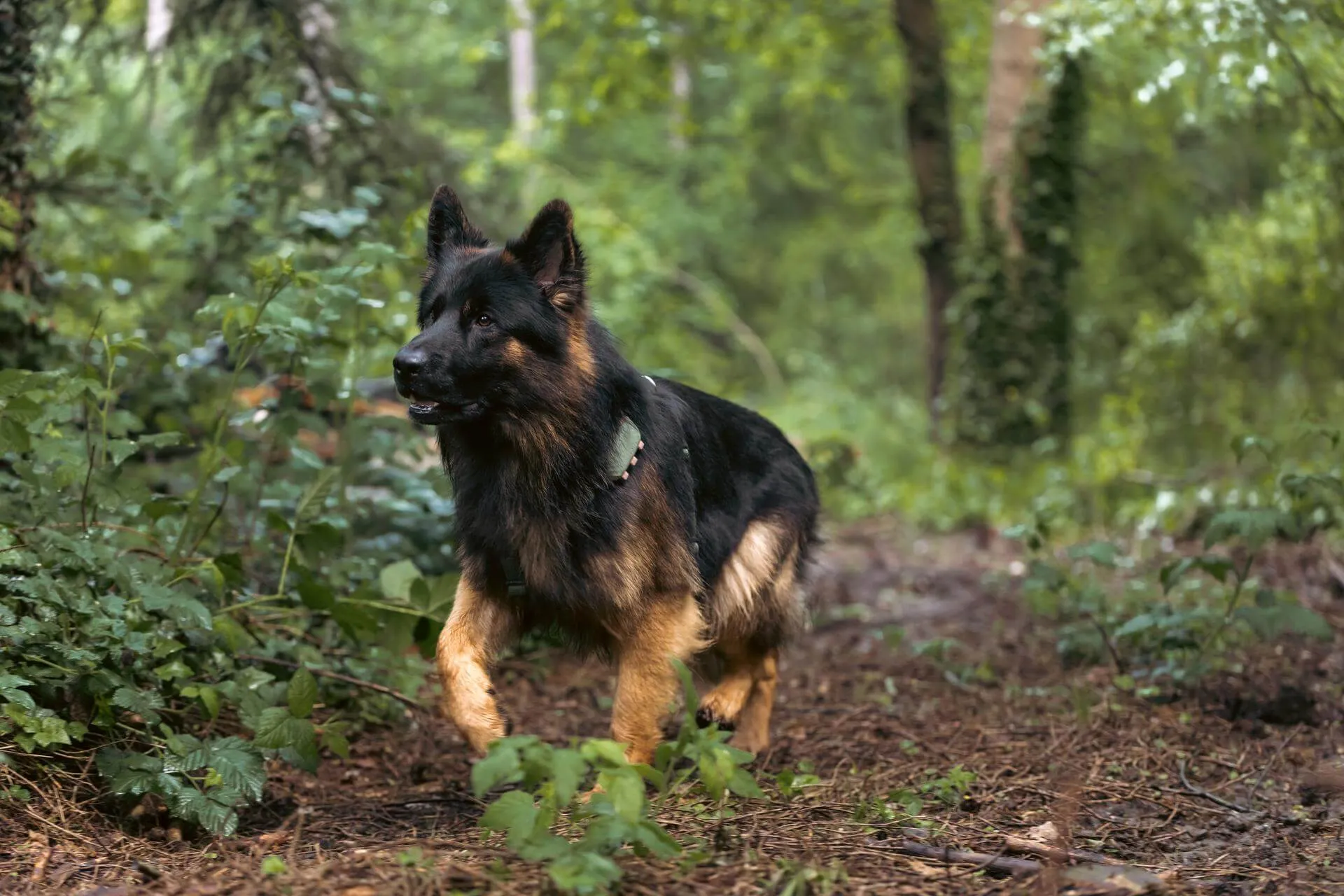Like humans, our canine companions thrive with opportunities to stretch their legs and explore freely, unrestricted by a leash. This makes knowing How To Train Your Dog To Come Off Leash a crucial part of responsible pet ownership, teaching them appropriate behavior in off-leash environments (where legally permitted, of course). This guide will walk you through the process of training your dog for off-leash adventures, ensuring these experiences are safe for everyone involved.
Understanding Off-Leash Dog Training
Off-leash dog training refers to the process of preparing your dog to safely navigate environments without a physical tether. This includes scenarios like walking, hiking, camping, or visiting designated nature parks. While basic obedience commands form the bedrock, off-leash training goes a step further, focusing on reliability and responsiveness in varied, distracting settings.
Best Dog Breeds for Off-Leash Training
Certain dog breeds, particularly those historically bred for hunting tasks like Retrievers and Spaniels, often demonstrate high trainability. This trait makes them more receptive to commands such as recall and general obedience, making them excellent candidates for off-leash activities. If your plans include wilderness hikes, camping trips, therapy work, or other off-leash pursuits, consider breeds like:
- Border Collie
- Labrador Retriever
- Golden Retriever
- Australian Shepherd
- German Shorthaired Pointer
Conversely, breeds with a strong prey drive, such as Siberian Huskies, Shiba Inus, Rhodesian Ridgebacks, or Coonhounds, might present a greater challenge for off-leash training. Similarly, dogs with aggressive tendencies may not possess the suitable disposition for reliable off-leash behavior. While not impossible, these situations often require more intensive training and management.
Is Your Dog Ready to Come Off Leash?
Before embarking on off-leash training, it’s vital to assess your dog’s current skills and temperament. Ask yourself the following questions to determine if your dog is prepared:
- Does your dog respond consistently to
basic obedience training? - Do they have a reliable
recall? - Do they exhibit good
impulse control? For instance, can they resist chasing after a squirrel or other distractions? - Does your dog interact positively with strangers, including other dogs and small children?
- Are they microchipped and wearing an ID tag?
- Are their vaccinations and flea/tick prevention up to date?
- Are you fully informed about the
leash lawsin your area? - Is your dog spayed or neutered? (The strong mating instinct can cause intact dogs to run off if they detect a female in heat.)
If you can confidently answer “YES!” to all these questions, you and your dog are likely ready to begin the journey of learning how to train your dog to come off leash.
Risks Associated with Off-Leash Dog Training
Even with thorough preparation, going off-leash carries inherent risks. If your dog has a history of running off due to prey drive, incomplete obedience training, or even boredom, it’s crucial to plan ahead for emergencies.
Allowing your dog to run off leash significantly increases the chance that they might run away. A sudden noise, an unfamiliar scent, or an unexpected encounter can spook your dog, causing them to bolt. Without a leash, you are solely reliant on voice commands to stop or recall your pet. In such scenarios, your dog could face dangers such as being hit by a car, getting into fights with other dogs or wildlife, becoming lost, or ingesting something toxic.
Furthermore, a loose dog can pose risks to people and other animals. They might initiate a fight with another dog, bite a person, or dart into the path of a cyclist, potentially causing an accident. It’s also important to remember that some people are fearful of dogs and will not appreciate an overly enthusiastic greeting from your unleashed pup.
The Importance of Local Leash Laws
Understanding and adhering to local leash laws is paramount. Many jurisdictions have laws prohibiting dogs from roaming off-leash, and city or town ordinances can be even more restrictive than state laws. These local regulations might require dogs to be “under control” – not always explicitly on a leash, but always under the owner’s immediate command. Some areas, like city parks, may mandate leashes no longer than 6 feet. Violators can face significant fines.
Likewise, international travel with your dog requires careful research into a country’s specific dog regulations. Some nations may entirely forbid off-leash activity, while others might even require a leash and muzzle for public transport. Always verify these rules before traveling with your dog.
The bottom line is that laws vary considerably from place to place. Always know the leash laws in your immediate area and any location you plan to visit with your furry friend.
How to Train Your Dog to Come Off Leash: Getting Started
The journey to successful off-leash freedom begins with a structured and patient approach, building a strong foundation of trust and obedience.
Start with Training Obedient Behavior
Before attempting to train your dog to come off leash, your dog must be proficient in basic obedience commands. Mastering these behaviors is vital for keeping them safe from precarious situations, such as encounters with wild animals, chewing on roadkill, or walking on thin ice. Key commands include:
- Sit: Your dog stops its current activity and sits, attentively looking at you.
- Stay: Your dog remains in place, even amidst distractions.
- Down: Your dog lies down at your feet.
- Go: Your dog moves to a designated spot, like their bed or crate.
- Heel: Your dog walks calmly beside you, not pulling ahead or lagging behind.
- Recall: Your dog promptly returns to you when called.
- Look: The dog focuses its attention on you or a specific object you indicate.
- Drop It: Your dog releases an object from its mouth.
- Leave It: Your dog ignores and walks away from an object or a chase.
You can teach these behaviors using voice commands, incorporating hand signals, whistles, or even a clicker. Always reward your pup with treats or praise to reinforce the learning. Integrate a 10-minute training session into your dog’s daily routine to keep their skills sharp. If you encounter difficulties with basic obedience, consider hiring a professional dog trainer or consulting online training resources. Do not proceed to off-leash training until your dog has mastered these foundational commands. Your role is to be a patient, calm, and assertive leader, maintaining control over your dog’s behavior and ready to intervene if something unexpected occurs.
Motivate with Treats
Treats are powerful motivators in dog training. Always carry a supply of high-value treats on your off-leash outings. If your dog is nearby and you need their attention, show them a few treats in your hand. For a dog further away, crinkling the treat bag can often be enough to signal that a reward is available.
Use a Long Leash
Before completely ditching the leash, attach a long line (a leash of 15-30 feet) or a retractable leash to your dog’s harness. This allows your pup to experience a degree of freedom while still maintaining a connection to you. As your dog explores, practice basic commands like heel, recall, or look at you. Repeat these commands frequently during your walks, always having treats ready.
After several outings with the long leash, assess your dog’s responsiveness. If your dog frequently ignores your commands, becoming too engrossed in exploration, more work is needed before transitioning to full off-leash freedom. Consistent practice helps how to train a puppy not to pull and prepares them for off-leash control.
Test Going Off-Leash in a Safe Place
Once your dog seems ready, practice going off-leash in a secure environment like your backyard or a fenced-in dog park. Unclip the leash with confidence and assertiveness, issuing frequent commands and generously rewarding your dog with praise when they obey.
Repeat this exercise on subsequent days, gradually introducing distractions like family members or friends. Maintain focus on issuing commands and closely observe your dog’s reactions. If a few sessions go well, your dog may be ready for real-world off-leash experiences. This controlled environment builds confidence before you train your dog to not use a leash in open spaces.
Emergency Commands
Alongside regular check-ins and recall practice, dedicate time to emergency commands such as “Sit” and “Down.” Practice these commands both when your dog is close by and when they are further ahead. For example, if you see a horse and rider approaching on a trail, recall your dog or command them to “Sit” until the horse has passed or you reach your dog’s side. Crucially, never chase your dog if they run off – this can inadvertently encourage them to run further, thinking it’s a game. A reliable “Leave It” command can also prevent your dog from pulling while walking or chasing distractions off-leash.
What to Do if Your Dog Starts to Run Away
Even with the best training, no amount of preparation can guarantee that an off-leash dog will never run away. If this situation arises, remain calm and employ these strategies:
- Stay Calm: Remember, you are the leader. Maintain a calm and assertive demeanor, calling your dog in a firm, even tone. Avoid sounding angry or fearful, as this can confuse or scare your dog further.
- Don’t Chase: Chasing your dog can be counterproductive, making them think you want to play, causing them to run faster. You are unlikely to outrun them. Your best approach is to rely on your training to
call them back. - Use Treats: Show your dog treats from your pocket or rustle the bag to capture their attention and entice them to return.
- Turn Away: Begin walking in the opposite direction while calling your dog’s name. Curiosity may prompt them to trot over to investigate your sudden change of direction.
Where a Smart Dog Tracker Can Prevent an Emergency
Even the most impeccably behaved dogs can surprise us. One moment they’re by your side, the next they’ve caught an intriguing scent, been startled by a sudden noise, or spotted a squirrel with lightning speed – and they’re gone. This is precisely where a smart dog tracker with real-time GPS tracking can transform a heart-stopping moment into a simple “Oops, there they are!”
 black dog in forest
black dog in forest
Attached to your dog’s collar, a reliable GPS tracker offers invaluable peace of mind:
- Real-Time Location: See your dog’s exact location on your phone with
LIVE tracking, which updates their position every few seconds. If they decide to take an unexpected detour, you’ll know their every move. Unlike devices like AirTags, you won’t be limited by a network of compatible devices or any range restrictions. - Escape Alerts: Set up “safe zones” around your yard or specific areas at the park using the app. If your dog crosses these invisible boundaries, you’ll receive an
escape alert, giving you an immediate head start to call them back.
 Screenshot of a Tractive app notification for a dog entering a safe zone
Screenshot of a Tractive app notification for a dog entering a safe zone Screenshot of a Tractive app notification for a dog entering a no-go zone
Screenshot of a Tractive app notification for a dog entering a no-go zone
- Discover Favorite Spots: Use the
Heat MapandLocation Historyfeatures to record your dog’s past adventures. In an emergency, such as if they go missing, you’ll know where to search first. - Stress-Free Outdoor Adventures: Many trackers are
durable and 100% waterproof, making them ideal for muddy puddles, unexpected downpours, and all the exciting explorations your furry friend might get into. Getting your puppy to like the leash is a great first step, but a tracker adds another layer of safety for off-leash outings.
With consistent training, patience, mastery of basic commands, and plenty of positive reinforcement, you’ll foster a strong bond of trust with your dog and be ready to enjoy memorable outdoor adventures together. Remember to always check local leash laws, start training gradually using a long line, and introduce your dog to quiet public spaces first. These steps will help you confidently achieve successful off-leash dog training in no time.
